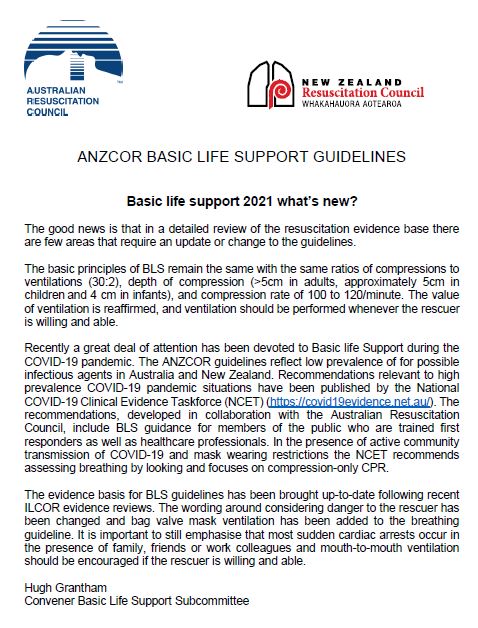The Australian Resuscitation Council has released new guidelines for Basic Life Support. A summary of the changes can be downloaded form this link. You can view the guidelines at this link.
Royal Life Saving Queensland is a member of the Australian Resuscitation Council (ARC). As trainers will recall, at the trainers workshops we have been discussing the recently updated ANZCOR guidelines. The ARC have now released new guidelines for Basic Life Support, which includes:
- ANZCOR Guideline 2 - Managing an Emergency
- ANZCOR Guideline 3 - Recognition and First Aid Management of the Unconscious Person
- ANZCOR Guideline 4 - Airway
- ANZCOR Guideline 5 - Breathing
- ANZCOR Guideline 6 - Compressions
- ANZCOR Guideline 7 - Automated External Defibrillation in Basic Life Support
- ANZCOR Guideline 9 - Cardiopulmonary Resuscitation
You can view the above guideline at this link.
The ARC have also released a summary of the changes which can be viewed at this link. The changes are not major, however we would like to point out to trainers the following matters:
Guideline 5 - 3.4 Bag valve mask
For rescuers trained in its use, bag valve mask ventilation is an alternative method option of providing rescue breathing A bag valve mask device is a self-inflating bag attached to a non rebreathing valve and face mask. There is an option to connect the bag to a reservoir and oxygen supply. There are different size devices for infants, children and adults: it is important to select the size appropriate to the person. Successful bag valve mask ventilation requires a patent airway (Guideline 4), adequate mask seal, and adequate ventilation technique. Prolonged bag valve mask ventilation or poor technique may introduce air into the stomach increasing the risk of regurgitation of gastric contents.
It is recommended that when bag valve mask ventilation is used, two trained rescuers provide ventilation for a non-breathing person: one to manage the airway, mask and seal, and the second to operate the bag. ANZCOR considers bag valve mask ventilation an extension to Basic Life Support thus it is not mandated in Basic Life Support training programs.
Note - Bold has been added to emphasize that the use of a BVM is not part of BLS trainer (i.e. not a requirement of regular CPR training for HLTAID009).
Guideline 7 - 2 Which rescuers should use an AED?
AED use should not be restricted to trained personnel. Allowing the use of AEDs by individuals without prior formal training can be beneficial and may be life saving. Since even brief training improves performance (e.g. speed of use, correct pad placement), it is recommended that training in the use of AEDs (as a part of BLS) be provided.
Note - Bold has been added for emphasis.
Guideline 7 - 5 Defibrillator Safety
There are no reports of harm to rescuers from attempting defibrillation in wet environments. In the presence of oxygen, there are no case reports of fires caused by sparking when shocks were delivered using adhesive pads.
Please note that Royal Life Saving training for the use of Oxygen has not changed at this time, our position remains:
- Ensure the patient is not lying in a pool of water (reference Pool Lifeguard Manual page 110), and
- that Oxygen should be turned off or minimum 1 m away (reference Pool Lifeguard Manual page 110) whilst a shock is applied.
Please do not hesitate to contact us if you have any questions.




